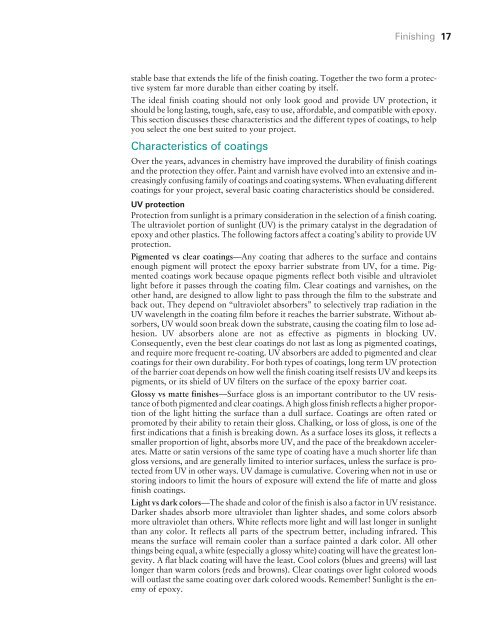Final Fairing & Finishing - WEST SYSTEM Epoxy
Final Fairing & Finishing - WEST SYSTEM Epoxy
Final Fairing & Finishing - WEST SYSTEM Epoxy
Create successful ePaper yourself
Turn your PDF publications into a flip-book with our unique Google optimized e-Paper software.
stable base that extends the life of the finish coating. Together the two form a protective<br />
system far more durable than either coating by itself.<br />
The ideal finish coating should not only look good and provide UV protection, it<br />
should be long lasting, tough, safe, easy to use, affordable, and compatible with epoxy.<br />
This section discusses these characteristics and the different types of coatings, to help<br />
you select the one best suited to your project.<br />
Characteristics of coatings<br />
<strong>Finishing</strong> 17<br />
Over the years, advances in chemistry have improved the durability of finish coatings<br />
and the protection they offer. Paint and varnish have evolved into an extensive and increasingly<br />
confusing family of coatings and coating systems. When evaluating different<br />
coatings for your project, several basic coating characteristics should be considered.<br />
UV protection<br />
Protection from sunlight is a primary consideration in the selection of a finish coating.<br />
The ultraviolet portion of sunlight (UV) is the primary catalyst in the degradation of<br />
epoxy and other plastics. The following factors affect a coating’s ability to provide UV<br />
protection.<br />
Pigmented vs clear coatings—Any coating that adheres to the surface and contains<br />
enough pigment will protect the epoxy barrier substrate from UV, for a time. Pigmented<br />
coatings work because opaque pigments reflect both visible and ultraviolet<br />
light before it passes through the coating film. Clear coatings and varnishes, on the<br />
other hand, are designed to allow light to pass through the film to the substrate and<br />
back out. They depend on “ultraviolet absorbers” to selectively trap radiation in the<br />
UV wavelength in the coating film before it reaches the barrier substrate. Without absorbers,<br />
UV would soon break down the substrate, causing the coating film to lose adhesion.<br />
UV absorbers alone are not as effective as pigments in blocking UV.<br />
Consequently, even the best clear coatings do not last as long as pigmented coatings,<br />
and require more frequent re-coating. UV absorbers are added to pigmented and clear<br />
coatings for their own durability. For both types of coatings, long term UV protection<br />
of the barrier coat depends on how well the finish coating itself resists UV and keeps its<br />
pigments, or its shield of UV filters on the surface of the epoxy barrier coat.<br />
Glossy vs matte finishes—Surface gloss is an important contributor to the UV resistance<br />
of both pigmented and clear coatings. A high gloss finish reflects a higher proportion<br />
of the light hitting the surface than a dull surface. Coatings are often rated or<br />
promoted by their ability to retain their gloss. Chalking, or loss of gloss, is one of the<br />
first indications that a finish is breaking down. As a surface loses its gloss, it reflects a<br />
smaller proportion of light, absorbs more UV, and the pace of the breakdown accelerates.<br />
Matte or satin versions of the same type of coating have a much shorter life than<br />
gloss versions, and are generally limited to interior surfaces, unless the surface is protected<br />
from UV in other ways. UV damage is cumulative. Covering when not in use or<br />
storing indoors to limit the hours of exposure will extend the life of matte and gloss<br />
finish coatings.<br />
Light vs dark colors—The shade and color of the finish is also a factor in UV resistance.<br />
Darker shades absorb more ultraviolet than lighter shades, and some colors absorb<br />
more ultraviolet than others. White reflects more light and will last longer in sunlight<br />
than any color. It reflects all parts of the spectrum better, including infrared. This<br />
means the surface will remain cooler than a surface painted a dark color. All other<br />
things being equal, a white (especially a glossy white) coating will have the greatest longevity.<br />
A flat black coating will have the least. Cool colors (blues and greens) will last<br />
longer than warm colors (reds and browns). Clear coatings over light colored woods<br />
will outlast the same coating over dark colored woods. Remember! Sunlight is the enemy<br />
of epoxy.
















